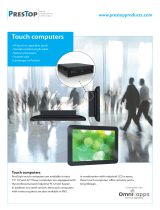
UC-5100 Series Hardware Introduction
Overview
The UC-5100 Series embedded computers are designed for industrial automation applications. The computers
feature 4 RS-232/422/485 full-signal serial ports with adjustable pull-up and pull-down resistors, dual CAN
ports, dual LANs, 4 digital input channels, 4 digital output channels, a SD socket, and a mini PCIe socket for
wireless module in a compact housing with convenient front-end access to all these communication interfaces.
Model Descriptions
The UC-5100 Series includes the following models:
• UC-5101-LX: Industrial computing platform with 4 serial ports, 2 Ethernet ports, SD socket, 4 DI, 4 DO,
-10 to 60°C operating temperature range
• UC-5102-LX: Industrial computing platform with 4 serial ports, 2 Ethernet ports, SD socket, mini PCIe
socket, 4 DI, 4 DO, -10 to 60°C operating temperature range
• UC-5111-LX: Industrial computing platform with 4 serial ports, 2 Ethernet ports, SD socket, 2 CAN ports,
4 DI, 4 DO,-10 to 60°C operating temperature range
• UC-5112-LX: Industrial computing platform with 4 serial ports, 2 Ethernet ports, SD socket, mini PCIe
socket, 2 CAN ports, 4 DI, 4 DO, -10 to 60°C operating temperature range
• UC-5101-T-LX: Industrial computing platform with 4 serial ports, 2 Ethernet ports, SD socket, 4 DI, 4 DO,
-40 to 85°C operating temperature range
• UC-5102-T-LX: Industrial computing platform with 4 serial ports, 2 Ethernet ports, SD socket, mini PCIe
socket, 4 DI, 4 DO, -40 to 85°C operating temperature range
• UC-5111-T-LX: Industrial computing platform with 4 serial ports, 2 Ethernet ports, SD socket, 2 CAN ports,
4 DI, 4 DO, -40 to 85°C operating temperature range
• UC-5112-T-LX: Industrial computing platform with 4 serial ports, 2 Ethernet ports, SD socket, 2 CAN ports,
mini PCIe socket, 4 DI, 4 DO, -40 to 85°C operating temperature range
The operating temperature range of the wide temperature models is:
-40 to 70°C with an LTE accessory installed
-10 to 70°C with a Wi-Fi accessory installed.
Package Checklist
Before installing a UC-5100 computer, verify that the package contains the following items:
• UC-5100 Series computer
• Console cable
• Power jack
• Quick Installation Guide (printed)
• Warranty card
Notify your sales representative if any of the above items are missing or damaged.
The console cable and power jack can be found beneath the molded pulp cushioning inside the product box.





















